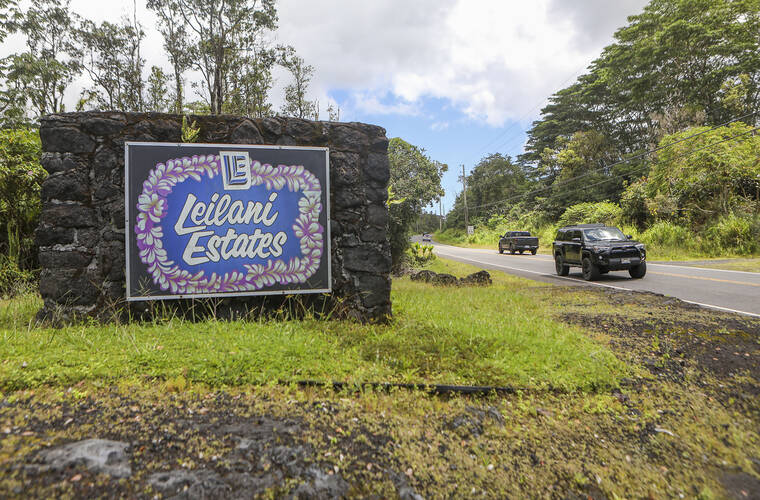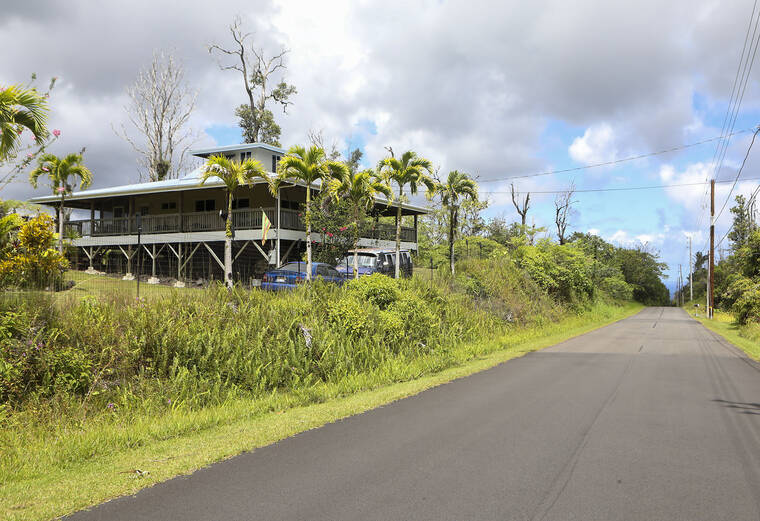A contentious meeting regarding homeowners insurance for Puna residents and others was held Wednesday at the Hawaiian Shores Community Center.
Roughly 130 people packed the center and watched through the windows while another 100 tuned in via Zoom.
The focus on drastically rising premiums for those living in lava zones 1 and 2, with some residents saying their rates rose by more than 400% and they are being priced out of their homes.
The increase resulted from Florida-based provider Universal Property and Casualty Insurance Co. announcing it is leaving the Hawaii’s homeowners, condominium and renters insurance market, impacting roughly 1,500 policyholders, about 900 of which are on the Big Island.
The only choice left for many residents in the lava zones is the Hawaii Property Insurance Association, a state-ran, last-resort option that underwrites insurance coverage for those unable to find another provider.
Insurance Commissioner Gordon Ito gave a brief presentation at the meeting about the reasons for HPIA’s high premiums and fielded a handful of questions from frustrated residents.
“I know there is a huge amount of concern with respect to what’s happening at HPIA, but there’s a bigger problem with the Hawaii market, too,” Ito said, adding reasons for the high rates include the increased cost of building materials, supply chain issues, a loss in reserves following the 2018 lava flow, and an increased cost of reinsurance, or the insurance that a provider secures to cover risk.
“Because of the lava flow, many of the reinsurers started saying, wait, this is a risky area, so the reinsurers started raising the reinsurance rate,” he said, noting HPIA suffered a $5 million net loss due to payouts from the 2018 eruption.
“The total loss for HPIA was $28 million at that time, but fortunately they had reinsurance, so their net loss was $5 million,” Ito said. “That triggered an even larger increase by reinsurers, and the cost for reinsurance by HPIA went up tremendously.”
Ito also expressed that insolvency, or the inability for an insurance company to meet their financial obligations to lenders, was a concern among providers.
“Insurers are not going to insure an area that they feel is too risky,” he said. “Any businesses, if your revenue is less than your expenses, you’re going to go into bankruptcy.”
The 2022 annual report from the Insurance Commissioner shows that homeowners paid over $418 million in premiums in 2021 throughout the state, while insurers paid out $153 million to losses, claims and benefits. But Ito noted there are other factors at play, including building back up lost reserves from prior payouts.
State Sen. Joy San Buenaventura, who represents Puna, said she is looking to see if the emergency proclamations for Maui could apply to Puna residents, including the foreclosure moratorium.
“I’m looking at the emergency proclamation that is occurring for Maui and seeing whether or not we can expand that to what’s happening here,” she said.
She noted U.S. Rep. Jill Tokuda is also looking at national-level solutions due to states like California and Florida also losing providers.
“Jill Tokuda, our congressional person, mentioned this and is looking into a bill related to federal disasters,” San Buenaventura said.
State Rep. Greggor Ilagan,who also represents Puna, attended via Zoom and proposed several long-term solutions.
These include updating HPIA’s current system to differentiate premiums for lava zones 1 and 2, improving the process of alerting consumers when an insurance company is leaving the state, subsidizing HPIA to potentially lower premiums, adjusting national flood insurance to include volcano hazards, and holding a special session of the Legislature to provide faster relief.
“We’ve been having discussions about special sessions because of what’s happening in Maui. At this point in time, there is no scheduled special session,” Illagan said. “A lot of these things still require some work, so if a special session were to happen right now, we’re still not ready.”
Ken Hon of the USGS Hawaii Volcano Observatory was left to address the remaining questions and offered a final presentation about the hazard map from 1992 that is used by insurance companies to evaluate risk.
“It is a lava flow hazard map, not a risk map,” Hon clarified. “This lava flow hazard map has been around for thirty some odd years, and the hazard hasn’t really changed, so what you hear insurance companies say is that the risks changed.”
Hon also noted the USGS does not calculate risk.
“The hazard map is just reporting what happened in the past. It’s not trying to project it into the future as to what is likely to happen,” he said. “We say, specifically, this is not a risk map. We are giving you hazard information, and then it’s really a social, political issue of what to do with that information.”
Residents closed out the meeting by offering potential solutions.
Suggestions included offering residents payment plans for premiums, separating volcano-related coverage from general homeowners insurance, setting aside a percentage of mortgages to go toward a disaster relief fund for the community, requesting federal assistance, and finding other ways to lure insurance providers back into the state.
“People are frustrated,” lower Puna resident Barry Albright told the Tribune-Herald after the meeting. “Ito was appalled when his insurance went up 20%. We’re not talking 20% here, we’re talking about 300- to-400%, up to 1,000%, and that’s ridiculous. How can anyone afford that?”
Albright proposed creating a new risk-focused map for the lava zones that takes topography into account.
“The property I have sits on a hill. It hasn’t had lava on it in two hundred years,” he said. “They’re simplifying this situation by not saying the probabilities. They just blanket a whole area, and we’re being beaten over the head with it by insurance companies.”
Fixed-income residents also were concerned with the immediate ramifications of higher premiums.
“This has been a trainwreck that has been in process since 2018,” said Puna resident Dave Price. “For many of us, what we keep hearing is wait it out, there’s not going to be a special session called, but what are we supposed to do? Right now, I’m uninsured, I don’t have insurance. I’m priced out of it, and if my house burns down tomorrow, I’m screwed.”
One favored solution among the crowd was a potential a la carte option. Much like flood, hurricane and earthquake coverage, they hope a decoupling of volcano-related coverage could lower premiums and entice providers back to the area.
While San Buenaventura promised to look into it, Ito said he previously spoke with reinsurer Lloyd’s of London, which said volcanic exclusion was an unlikely option.
Residents also questioned why there is no cap on premium rate increases by providers like there are in Florida, where increases cannot exceed 13%.
“California and Florida have put in many restrictions, and that’s why insurance companies decide that because of the restrictions, say the 13% limitation, they leave,” Ito said. “If you limit what can be increased, you may end up with an inadequate rate.”
But residents said they feel the overall burden of increased prices, reinsurance rates, inflation and previous disasters are being placed on them without any help or potential solutions being offered.
“I can’t afford a $1,000-a-month payment for house insurance,” Albright said. “That’s ridiculous.”
Email Grant Phillips at gphillips@hawaiitribune-herald.com.





